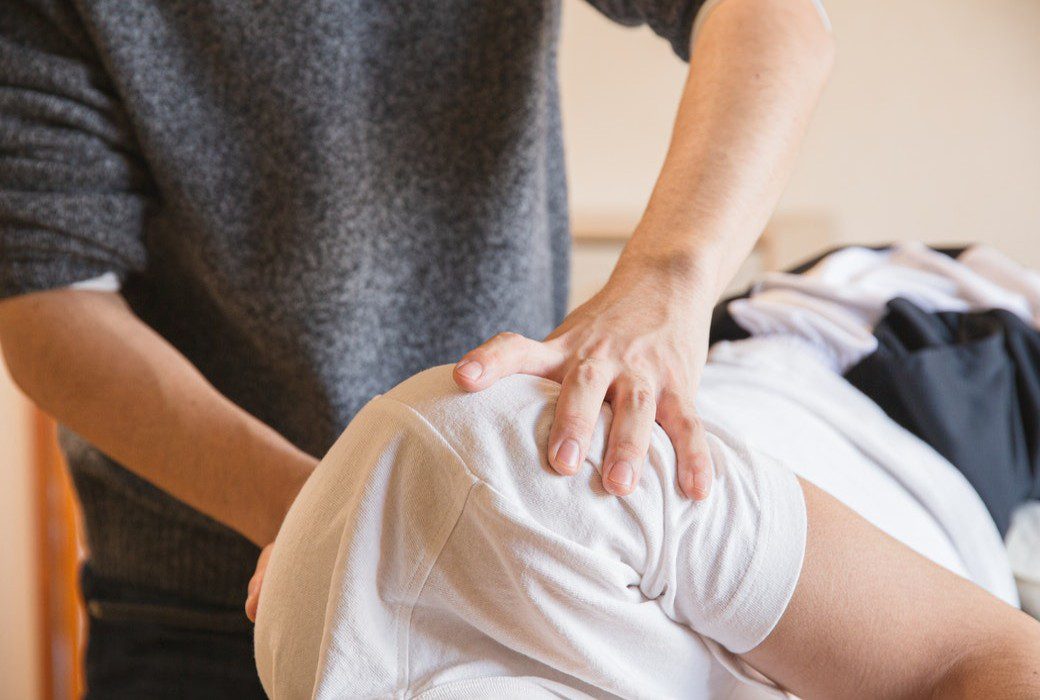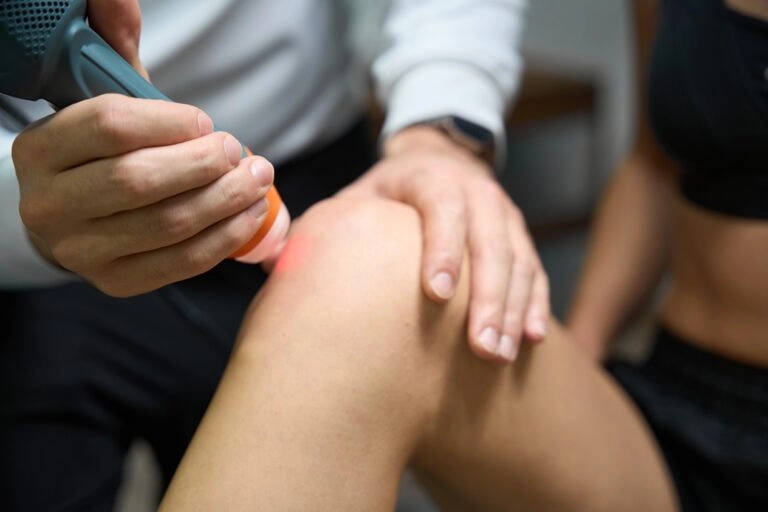There are few things worse than failing to get adequate sleep. And when shoulder pain is keeping you from sleeping, it only adds fuel to the fire.
If you’re experiencing shoulder pain at night, it’s likely caused by inflammation of the rotator cuff. This can present as an ever-present, dull pain or a sharp pain that comes from movement. Luckily, we’ve got 10 tips to kill rotator cuff pain at night effectively.
- Heat and Ice
- Pain Cream or Pain Medication
- Shoulder Stretches
- Sleep in a Reclined Position
- Sleep on Your Opposite Shoulder
- Sleep with a Propped Up Shoulder
- Chiropractic Care
- Physical Therapy
- Injections
- Surgery
Rotator Cuff Pain Causes
Most people who experience rotator cuff pain at night can’t point to a specific injury that could be the culprit. The shoulder is a complex joint that can cause us pain as we get older.
Of course, people that have experienced a specific shoulder injury, such as a pulled shoulder muscle, can also have pain in the shoulder at night. But for the majority of people, there’s no exact cause they can think of. This is normal.
There are a few different issues that are usually to blame for rotator cuff pain at night:
- Frozen Shoulder
Inflammation leading to stiffness which can feel like the shoulder joint is frozen.
- Rotator Cuff Tear
A tear in a rotator cuff tendon can definitely cause pain and inflammation at night.
- Subacromial Bursitis
There’s a fluid-filled sac in each shoulder just above the rotator cuff. When these sacks, known as bursae, become irritated and inflamed, it can cause pain.
- Rotator Cuff Tendonitis
Tendonitis is usually caused by overuse. It can cause pain in the shoulder when the tendons become irritated and inflamed.
How Do You Relieve Rotator Cuff Pain At Night?
There’s no one-size-fits-all approach to relieving rotator cuff pain at night. But there are some tactics that work for most people experiencing shoulder pain at night.
However, if your rotator cuff pain gets worse over time, or it’s keeping you from sleeping more than a few hours a night, you should consider seeing a chiropractor or physical therapist for treatment. An untreated rotator cuff issue can cause long-term problems, so it’s best to seek help if the home remedies below don’t seem to help.
Home Remedies for Rotator Cuff Pain at Night
These first tips are all about things you can do at home to remedy your rotator cuff pain at night. It’s important to try home remedies before moving onto other options unless you’re experiencing severe pain or other worrying symptoms.
1. Heat and Ice
You may be surprised to find that heat works better than ice for your shoulder pain at night. Applying a heating pad to your shoulder for 15 minutes on and 20 minutes off until you feel relief can help you get to sleep with little to no pain. Reading or listening to a book while you do this can get you ready for sleep, just be careful to not fall asleep with the heating pad on.
If you don’t experience relief with heat alone, you can try ice for 15 minutes on and 20 minutes off, as well. Most people find more soothing relief with heat, but you may respond well to ice. You can also try alternating heat and ice for the best of both worlds.
2. Pain Cream or Pain Medication
Applying pain cream to the shoulder before sleep can help you rest through the night despite a rotator cuff issue. The same can be said for pain medications such as ibuprofen and other over-the-counter medications.
But if you find yourself wanting to take more than the recommended dose, or you think you need to apply pain cream more than the instructions advise, it’s probably time to see a medical professional, such as a chiropractor for shoulder pain relief.
3. Shoulder Stretches
Those who don’t experience much pain during the day may benefit from shoulder stretches throughout the day and before bed. Certain stretches and movements can help strengthen the rotator cuff and promote healing. If you experience pain any time during the stretches, stop them at once. You shouldn’t feel pain, but you may feel a mild strain on the muscles you’re stretching.
Here are some good shoulder stretches to try:
- Across the chest stretch.
- Chest expanding stretch.
- Shoulder rolls.
- Doorway shoulder stretch.
Yoga can also be beneficial for shoulder pain. Even 10 to 30 minutes of yoga a day can help your shoulders at night.
How to Sleep With Rotator Cuff Pain at Night?
These next tips are all about sleeping positions that may work for you. If one doesn’t work, try the next until you find a way you can get some rest.
4. Sleep in a Reclined Position
Instead of sleeping horizontally, many people find relief from rotator cuff pain when they sleep in a reclined position. This can be done in a recliner or in a bed with pillows to prop you up at approximately a 45-degree angle. Whether you’re dealing with posterior or anterior shoulder pain, sleeping this way should help.
5. Sleep on Your Opposite Shoulder
If you find it hard to sleep on your back in a reclined position, you may want to try sleeping on your side. Of course, this means sleeping on the shoulder that isn’t causing you pain. To avoid turning over onto your other shoulder, you can place a pillow behind your back and/or in front of you. This should keep you from rolling onto the injured shoulder.
6. Sleep with a Propped Up Shoulder
If the two tips above don’t seem to work for you, there’s one more sleeping position that may be beneficial for your rotator cuff pain. While sleeping flat on your back will often cause pain in the injured shoulder, you may find success by propping the arm and shoulder up on a pillow as you sleep.
For some people, just putting the arm up helps. For others, putting the pillow under the shoulder may work better. It’s best to do what you’re comfortable with and what helps you sleep.
Medical Remedies
The following tips are all about medical remedies for rotator cuff pain at night. Most people will experience relief with conservative treatments, such as chiropractic care. But a small portion of people may need injections and/or surgery.

7. Chiropractic Care
Shoulder pain that is persistent or extremely painful should be addressed first with conservative treatment options. Chiropractic care is one of the most effective non-invasive options for rotator cuff treatment. A chiropractor can help shoulder impingement and other injuries with a combination of modalities.
Some common tactics include:
- Anti-inflammatory techniques such as ultrasound, cold laser, heat and ice, and mobilization.
- Chiropractic adjustment of the joints, including the spine, which is often a factor in rotator cuff pain.
- Active release techniques to clear scar tissue due to traumatic or overuse injuries that may be causing impingement.
- Massage therapy for pain relief and to promote healing.
- Stretching to strengthen the area.
8. Physical Therapy
Physical therapy is also another good option for conservative treatment of rotator cuff pain. Most often, physical therapy works best when used in conjunction with chiropractic care. The two methods are similar and tend to complement each other, especially when it comes to shoulder pain.
Physical therapy focuses on strength and recovery and less so on pain relief and inflammation reduction, which is why many chiropractic offices have physical therapists on staff.
9. Injections
Some physicians will perform steroid injections to relieve pain. This is often used only for those who have already been trying other conservative treatment options but haven’t had any luck. Injections may also be used on those who are experiencing severe pain.
However, steroid injections should not become a main treatment option, as they may not be effective for everyone and can cause degradation of the tendons when done too many times.
10. Surgery
Most people don’t need surgery for rotator cuff issues, but it is an option when all other tactics have been exhausted. The specific type of surgery performed depends on what is causing the rotator cuff night pain.
Since all surgery is generally riskier than conservative treatments, it’s important that it only be considered as a last resort.
Resources:
https://www.webmd.com/pain-management/what-is-subacromial-bursitis
https://www.healthline.com/health/shoulder-pain-exercises#across-the-chest
https://www.sciencedirect.com/science/article/abs/pii/S0161475411000625
https://www.cochranelibrary.com/cdsr/doi/10.1002/14651858.CD004016/abstract









